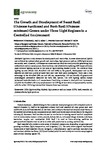The Growth and Development of Sweet Basil (Ocimum basilicum) and Bush Basil (Ocimum minimum) Grown under Three Light Regimes in a Controlled Environment
| dc.contributor.author | Aldarkazali, | |
| dc.contributor.author | Rihan, Hail | |
| dc.contributor.author | Carne, | |
| dc.contributor.author | Fuller, MP | |
| dc.date.accessioned | 2019-11-20T15:20:55Z | |
| dc.date.available | 2019-11-20T15:20:55Z | |
| dc.date.issued | 2019-11-11 | |
| dc.identifier.issn | 2073-4395 | |
| dc.identifier.issn | 2073-4395 | |
| dc.identifier.other | ARTN 743 | |
| dc.identifier.uri | http://hdl.handle.net/10026.1/15170 | |
| dc.description.abstract |
<jats:p>Light is a crucial element for plant growth and production. In areas where natural light is not sufficient for optimal plant growth and production, high pressure sodium (HPS) light sources are widely used. However, HPS lamps are considered not very electrically efficient generating high radiant heat and as a consequence, there has been a lot of interest in replacing HPS lamps with new more efficient lighting sources in the form of light-emitting diodes (LEDs). The effects of three lighting sources (White LED, Blue/Red LED and HPS) on the growth, development and on the essential oil yield and quality of sweet basil and bush basil were investigated. There was a clear advantage to the Blue/Red (452 nm and 632 nm, respectively) LED on virtually all growth and physiological parameters measured for both basil species. The HPS lighting system always performed least effectively in all comparisons. Combining increases in plant yield and increases in oil yield the Blue/Red LED array outperformed the HPS lights by a factor of approximately double, with the white LED being intermediate between these two extremes.</jats:p> | |
| dc.format.extent | 743-743 | |
| dc.language | en | |
| dc.language.iso | en | |
| dc.publisher | MDPI AG | |
| dc.subject | LEDs (light-emitting diodes) | |
| dc.subject | high-pressure sodium lamps (HPS) | |
| dc.subject | basil | |
| dc.subject | essential oil | |
| dc.subject | photosynthesis | |
| dc.subject | light spectrum | |
| dc.title | The Growth and Development of Sweet Basil (Ocimum basilicum) and Bush Basil (Ocimum minimum) Grown under Three Light Regimes in a Controlled Environment | |
| dc.type | journal-article | |
| dc.type | Journal Article | |
| plymouth.author-url | https://www.webofscience.com/api/gateway?GWVersion=2&SrcApp=PARTNER_APP&SrcAuth=LinksAMR&KeyUT=WOS:000502264700077&DestLinkType=FullRecord&DestApp=ALL_WOS&UsrCustomerID=11bb513d99f797142bcfeffcc58ea008 | |
| plymouth.issue | 11 | |
| plymouth.volume | 9 | |
| plymouth.publication-status | Published online | |
| plymouth.journal | Agronomy | |
| dc.identifier.doi | 10.3390/agronomy9110743 | |
| plymouth.organisational-group | /Plymouth | |
| plymouth.organisational-group | /Plymouth/Faculty of Science and Engineering | |
| plymouth.organisational-group | /Plymouth/Faculty of Science and Engineering/School of Biological and Marine Sciences | |
| plymouth.organisational-group | /Plymouth/REF 2021 Researchers by UoA | |
| plymouth.organisational-group | /Plymouth/REF 2021 Researchers by UoA/UoA06 Agriculture, Veterinary and Food Science | |
| plymouth.organisational-group | /Plymouth/Users by role | |
| plymouth.organisational-group | /Plymouth/Users by role/Academics | |
| dcterms.dateAccepted | 2019-11-06 | |
| dc.rights.embargodate | 2019-11-27 | |
| dc.identifier.eissn | 2073-4395 | |
| dc.rights.embargoperiod | Not known | |
| rioxxterms.versionofrecord | 10.3390/agronomy9110743 | |
| rioxxterms.licenseref.uri | http://www.rioxx.net/licenses/all-rights-reserved | |
| rioxxterms.licenseref.startdate | 2019-11-11 | |
| rioxxterms.type | Journal Article/Review |


